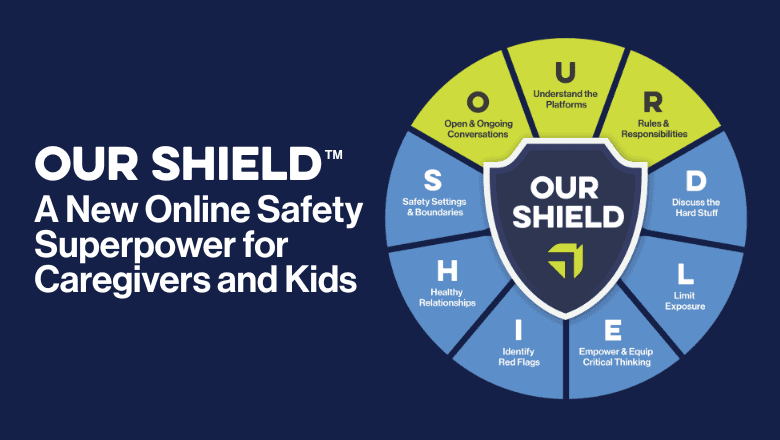We are raising a generation of children in a world more connected and complex than before in an ever-evolving digital maze. From toddlers swiping tablets, tweens in group chats, and teens navigating TikTok trends, our kids are growing up in the new wild west. This digital frontier—rooted in smartphones, social media and vast online access—shapes their identities, relationships, mental health and especially their safety.
In the United States, children ages 8 and younger spend an average of 2 1/2 hours a day on screens, with those younger than 2 exceeding an hour daily, according to a recent report from Common Sense Media. The report also found that by age 4, more than half of children have their own tablet, and nearly one in four have their own phone by age 8.
We thought we’d never be the parents who handed our kids a tablet at the dinner table. Then reality hit,” said Jillian, a mother of two girls ages 10 and 12. “You have all these ideas before you start, and then you become a parent and you’re kind of in it and doing just the best you can to survive.
Parents, guardians, or caregiving roles aren’t meant to simply banish our kids from the online world, but rather to properly prepare them for it. Still, many feel overwhelmed with the digital decisions starting earlier than ever. What age do we hand them an iPad? Allow them to game online? Give them a cellphone? Let them join social media?
Kelly Crouch, strategic advisor for the Washington State Internet Crimes Against Children Task Force, put it simply: “We equip kids to understand stranger danger and not walk to the park alone, yet we give them few guidelines when we hand them a digital device. As parents, we need to have open, honest conversations with our kids and reward them for coming to us. When your child reports bullying or inappropriate content, that should be met with empowerment, not punishment.”
Parents seek a mindset shift while wrestling with a growing dissonance to delay technology and the simultaneous fear of leaving kids behind. When parents hand kids a device—often with access to the far corners of the internet—we rarely offer the same level of guidance as other childhood rites of passage.
Just 46 Minutes
A leading survey from Kaspersky, a global cybersecurity and digital privacy company, found that while 84% of parents are concerned about their child’s online safety, they spend an average of just 46 minutes discussing it with their kids over the course of their entire childhood. Forty-six minutes–that’s less just a few minutes each year of their childhood, which could be attributed to a gap in the tools for parents and caregivers to begin these conversations.
It can feel like a no-win scenario unless we reframe the conversation as a society, according to John Trenary, Our Rescue’s head of mission for Asia, Africa and the Middle East.
“We don’t like to believe that the boogeyman is out there. We want to be able to go to bed and know that someone’s not going to jump out of the closet. We want to feel safe in our lives. And so ignoring online child sexual exploitation is encouraging the problem,” said Trenary.
The Risks– and the Research
The risks aren’t hypothetical, and are already impacting young children in a matter of a few clicks. Whether it’s exposure to disturbing content, online predators, gaming with strangers, sextortion, pornography, deepfakes, or CSAM (child sexual abuse material), there’s a new digital threat each day. Even more alarming, research is showing that the shift from play-based childhoods to phone-based upbringings is wreaking havoc on kids’ mental health.
- In a 2024 Pew Research Center survey, 48% of U.S. teens reported that social media has a mostly negative effect on people their age, up from 32% in 2022.
- According to research from Thorn, 1 in 3 minors ages 9-17 reported they have had a sexual interaction online, including 1 in 5 kids ages 9-12.
- A report from Common Sense Media found that 73% of teen respondents ages 13 to 17 have watched pornography online—and 15% of teen respondents said they first saw online pornography at age 10 or younger. The average age of viewing pornography was 12-years-old, according to Common Sense Media.
- The FBI and NCMEC have reported a dramatic rise in sextortion cases in the past several years after the COVID-19 pandemic. The FBI data shows that law enforcement agencies received over 7,000 reports of online sextortion of minors in recent years, involving at least 3,000 victims—primarily boys. Sadly, at least a dozen victims have died by suicide.
But there is something parents and guardians can do. Introducing “Our Shield™”: A New Online Safety Superpower

At Our Rescue, we believe online safety isn’t a one-time conversation but instead a lifelong age-appropriate dialogue that evolves as our children do. In response to this urgent need, Our Shield™ is a new initiative and stage-based online safety guide built on Our Rescue’s key values of trust, transparency, education and prevention, with these four grounding principles:
- Digital safety starts early and grows with your child over their life, as you build trust to lay the groundwork for critical conversations.
- Empowered and educated kids are safer kids no matter the platform. When they know how to navigate evolving technologies, they are more equipped to handle what comes their way.
- Parents need more than warnings, they need tools and support, too.
- Technology should serve children—not exploit them.
O – Open and Ongoing Conversations

When it comes to digital safety, the best defense begins with dialogue. Start early and talk often. Keep lines of communication open so kids feel safe coming to you with anything they encounter online.
In early childhood, brain development is rapidly underway, with over a million new neural connections forming every second, according to Harvard’s Center on the Developing Child. At this stage, Harvard researchers recommend that screen time be limited and involve co-viewing with a parent or caregiver to provide context and connection. From their first moments with a screen, narrate what they’re seeing. Watch together or ensure screens are within your line of sight.
This is exactly what Sara has long practiced alongside her now 11-year-old daughter, who she describes as curious, and highly connected. Still, Sara realized it would take more to stay steps ahead of her daughter in the age of digital parenting.
I didn’t have an idea of how hard it was going to be. Once she knew what YouTube was, it was like trying to put toothpaste back in the tube,” said Sara. “The first time we watched her in VR, I asked, ‘Who are those people?’ She said she didn’t know — and she could talk to them. I had no idea.
Trust is the foundation of digital safety. When you build trust and encourage open dialogue, you create space for your child to come to you when they need help most.
U – Understand the Platforms
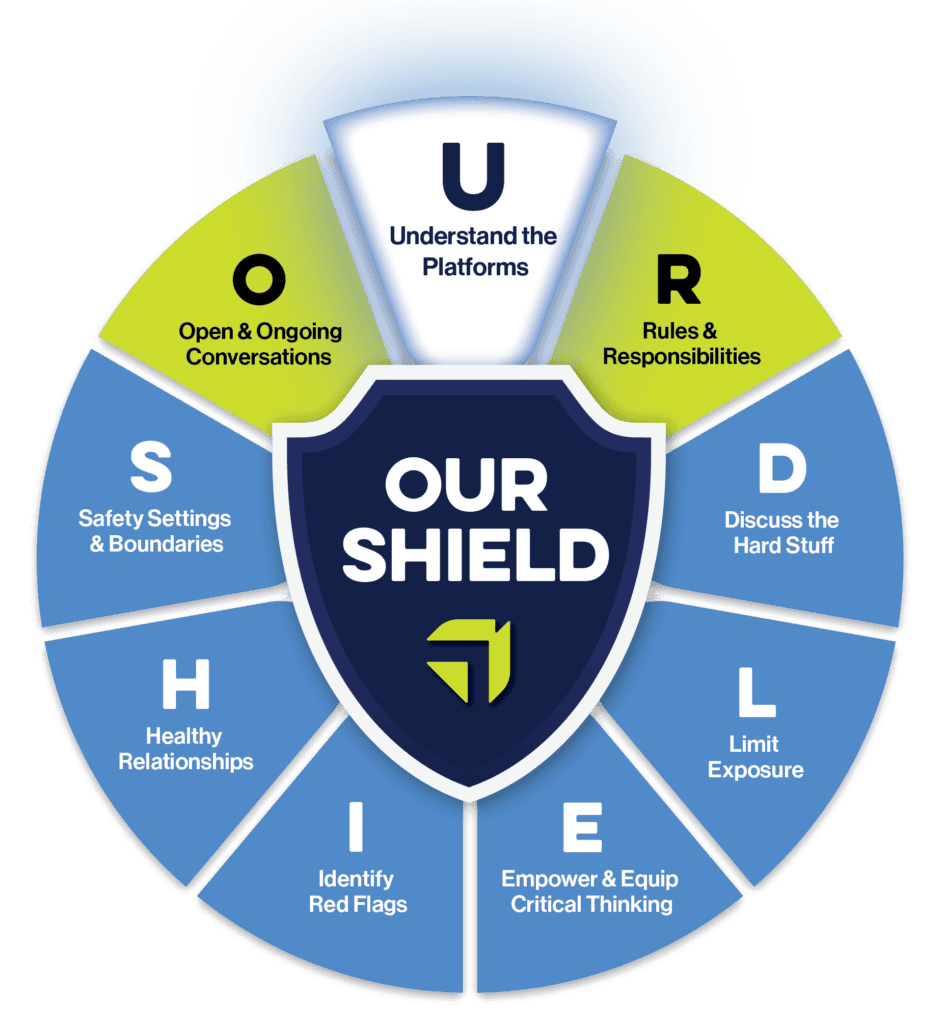
Step into their digital world. Get to know the apps, games, and websites your kids use. Ask questions, listen with curiosity, and try to understand how they experience and use technology. Learn where the dangers and protections exist. Presence is one of the best forms of protection. Try a game together, watch their favorite videos, or explore their hobbies, even if it’s unfamiliar to you.
Sara, a social media manager, knows the platforms well and still has reservations for her son. “Working in social media has made me double down on my goal: keep him off social media as long as possible.I’m already talking with other moms about delaying phones and social media. It helps when kids know they’re not the only ones,” she said.
Parental controls and privacy settings offer some protection, but kids at this stage can also begin learning about their digital footprint and how to critically evaluate what they see online. Great tools include Common Sense Media and NetSmartz from the National Center for Missing & Exploited Children (NCMEC).
R – Rules and Responsibilities
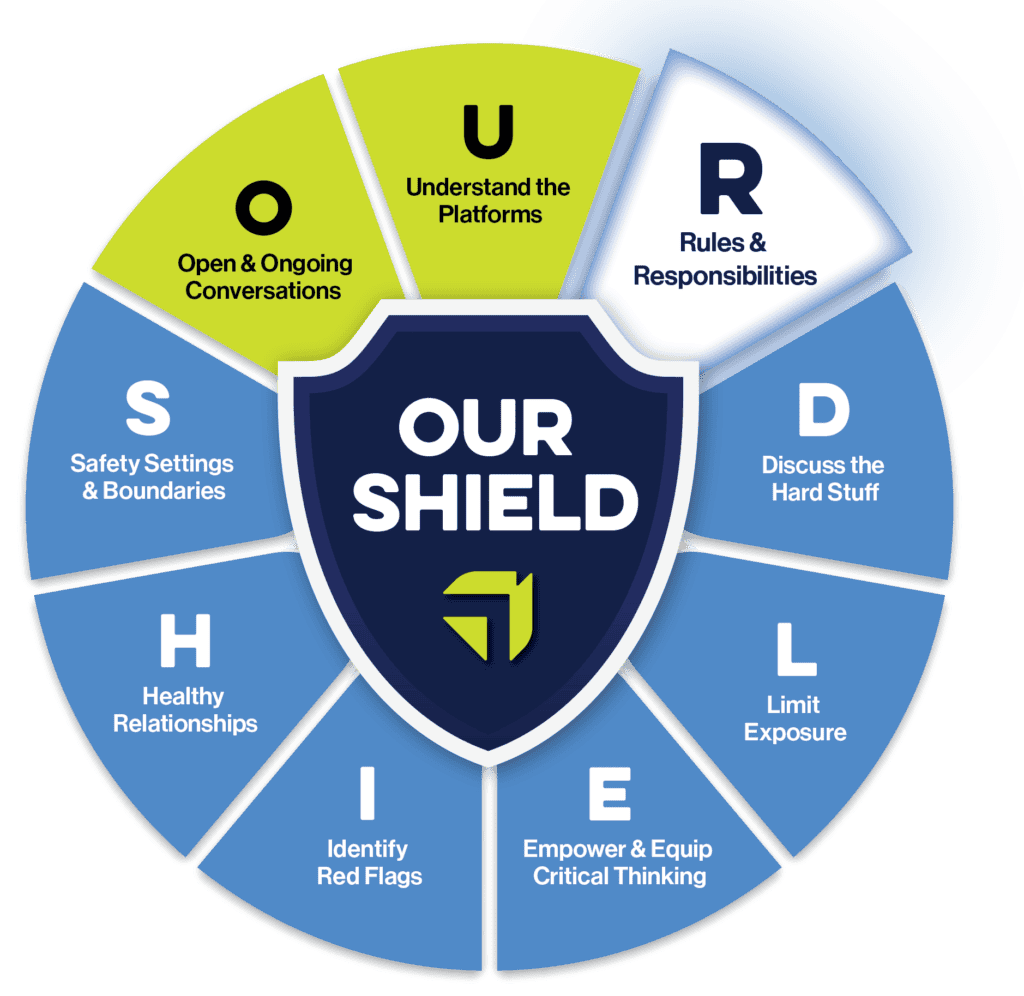
Set age-appropriate guidelines for screen time, social media, gaming, and overall device use. Use research from trusted sources to guide what’s appropriate. Boundaries help kids feel secure, even when they push back, which is a natural part of development.
The American Academy of Pediatrics (AAP) provides screen time guidelines and encourages parents to have frequent, evolving conversations with their children about their online lives. Younger kids may be more open when their screen use happens in shared, visible spaces. Promote digital buddy systems: “Tell a friend or adult if you see something harmful.”
Maci, a Utah mother of a toddler who is pregnant with her second child, says she tries to limit her toddler’s screen time to four days a week.
“But we try to keep it under an hour and it’s usually just an educational show. But I try to limit personal devices. I think that iPads and phones are a more potent type of stimuli that’s a little bit more addictive,” said Maci.
S – Safety Settings and Boundaries
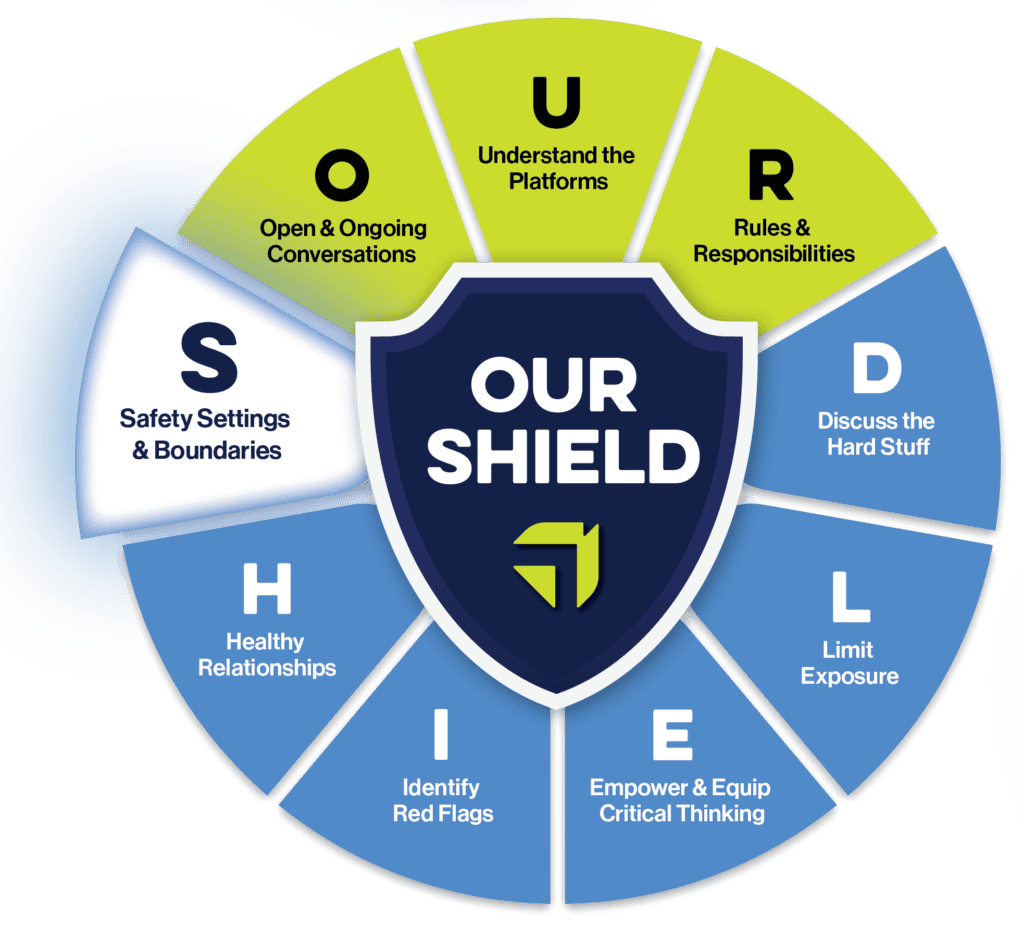
Keep personal info private from names, addresses, passwords, and school details. Use parental controls, filters, and privacy settings on devices and apps. While not foolproof, these tools provide a helpful framework. Regularly check online activity together, like browsing history, app usage, and chats. This is not to spy, but to invite conversation.
In middle childhood, kids begin to explore more independently, making it an ideal time to introduce clear boundaries, age-appropriate safety lessons, and critical thinking skills. Teach children to recognize red flags like unsolicited messages or requests for personal information and use role-play to practice how to respond.
A Pew Research Center survey recently found about half of parents polled look through their teens’ phone. As a homeschooling mom of two daughters and a longtime youth ministry leader, Jillian has seen firsthand how fast kids can be drawn into online platforms and how difficult it is for parents to stay a step ahead.
We have no doors closed, no headphones on in the house. I tell my kids they can have privacy when they move out of my house. We are constantly looking at their search history, web browser history, and have a ton of parental controls — especially with Roblox. They can’t do the chat feature at all,” said Jillian.
Last, don’t simply “pull the plug.” Taking away access can backfire. Instead, collaborate on a solution that addresses the issue and empowers them to be part of the solution.
H – Healthy Relationships
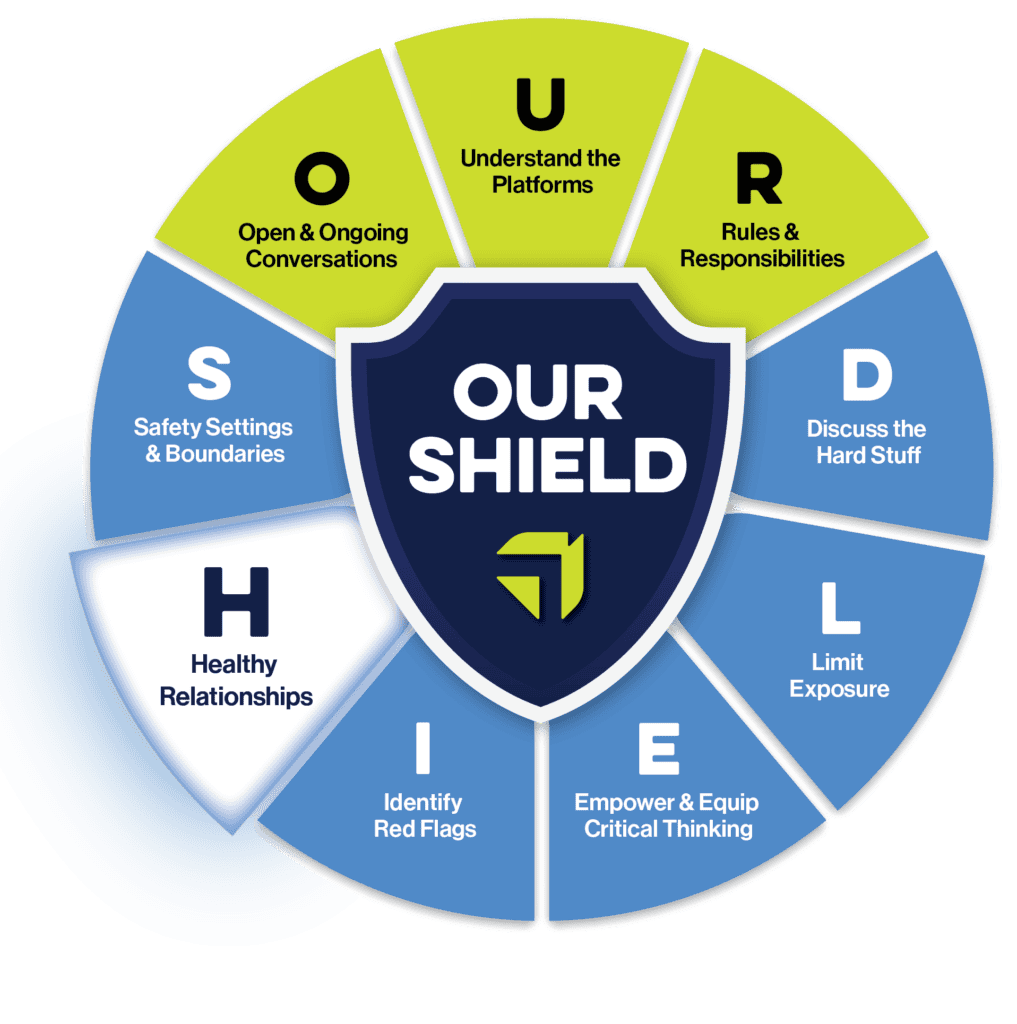
Model respectful, balanced technology use. Young people are rapidly developing their digital identities and social lives.. Conversations should be frequent and judgment-free, covering mental health, relationships, and the influence of algorithms. Show how you manage your own screen time and online interactions. Be a judgment-free zone so your child feels safe sharing their concerns or questions.
I had unrealistic expectations of what type of relationship my child would have with screens. Once their interests expand and their friends are doing certain things online, some of those expectations go out the window,” said Kristin, a mother of a 6-year-old boy. “We utilize screens sometimes just to free up a little bit of time to get things done. We both work full-time. Life is busy.
Even in the whirlwind pace of life, it’s helpful to be curious about their interests, whether it’s a trend, game, or online friend group. Learn the lingo. Stay up to date on the terms and slang teens are using. Your interest builds your influence. That kind of vulnerability builds connection and safety. Talk openly about your own digital habits, mistakes, and lessons learned.
I – Identify Red Flags

Teach kids from the beginning to recognize warning signs online: strangers asking for private info, flattery, secrecy, or anything that feels “off.”
In just 19 seconds, online predators can initiate contact with a minor, according to the WeProtect Global Alliance. Remind them that when someone has a bad day, they may be more vulnerable to manipulation. Model help-seeking behavior: “If something feels weird, tell me right away.” Ask: “What would you do if something felt off?” Help them think through possible scenarios and how they would respond.
Tweens may become more private, but regular, respectful check-ins are still vital—curiosity-based questions like “What’s something interesting you’ve seen online this week?” can keep dialogue open. Parents should watch for mood changes or withdrawal, which may signal online issues, and foster empathy by encouraging healthy online friendships and discussing topics like cyberbullying, sextortion, and respectful communication. If you notice a shift in behavior, trust your gut.
E – Empower and Equip Critical Thinking
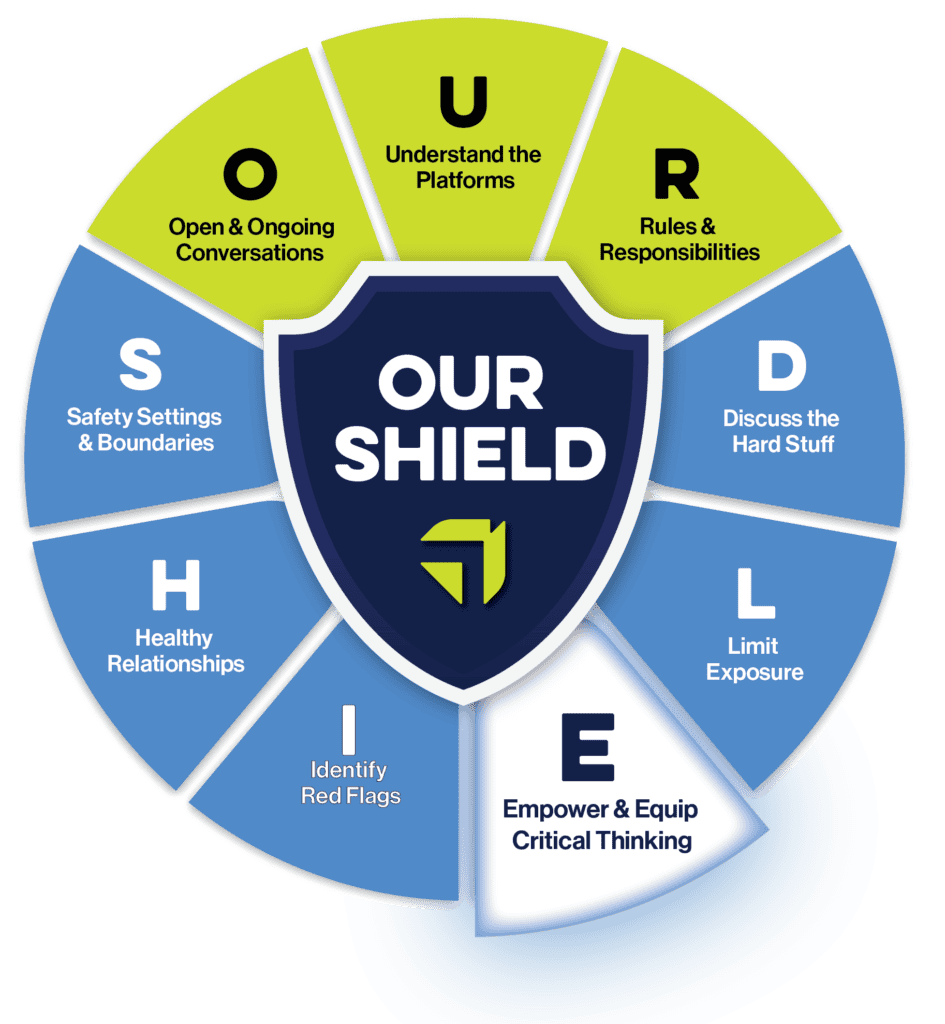
Encourage kids to pause and ask: Is this real? Is it safe? Should I tell someone? And, who is safe to tell? Empower them to respond with confidence and come to you without fear of punishment. Practice and repeat what to do if they encounter harmful or uncomfortable messages or online content.
Growing independence and exposure to social media require a deeper focus on media literacy, self-regulation, and emotional intelligence. The American Academy of Pediatrics emphasizes the importance of guiding children to question the reliability of online sources and to think before sharing content. While teens need autonomy, they benefit from continued adult guidance and modeling of healthy tech habits.
Last, teach resilience tools such as to cope with distressing content, navigate complex social dynamics, and recognize manipulative behavior. These skills prepare them to thrive in a connected world. Tia, a mother of two boys, ages 17 and 20, has reaped the rewards of this approach understanding that open conversations earn trust.
About 16 or 17 is when we started to feel more comfortable. We had a lot of conversations early on about internet safety,” said Tia. “Now that my youngest is older, we know he’s going to do a sleepover and all the buddies are bringing their video games… and that’s okay. He’s old enough to make those decisions.
L – Limit Exposure
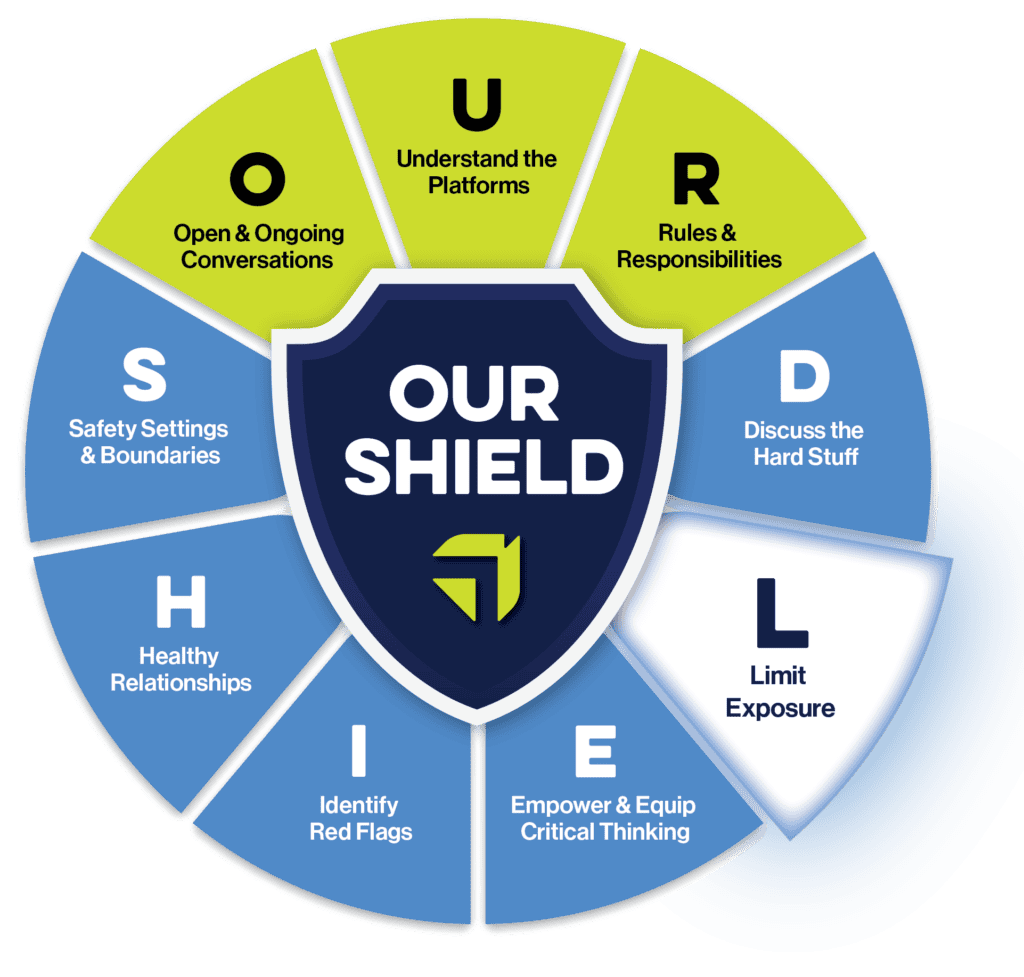
The American Academy of Pediatrics (AAP) recommends creating a personalized Family Media Plan that includes expectations around screen time, device use, and online behavior. Foundational digital habits help children and teens build routines rooted in human interaction and creativity.
Keep devices out of bedrooms and create screen-free zones. Set time limits and build routines that prioritize sleep and mental health. Encourage co-play and screen-sharing. Talk about who they interact with online.
Lindsey, a mother of a 13-year-old, understands this tension well. Her son is one of the last in his class without a cell phone. “I worry I’m disconnecting him from his peers,” she admits. “But he’s neurodivergent and more vulnerable to online harms. In my gut, I know he’s not ready to have this device in the palm of his hand.”
Agree on boundaries together to build trust and consistency. Involve your child in setting boundaries so they feel ownership.
D – Discuss the Hard Stuff
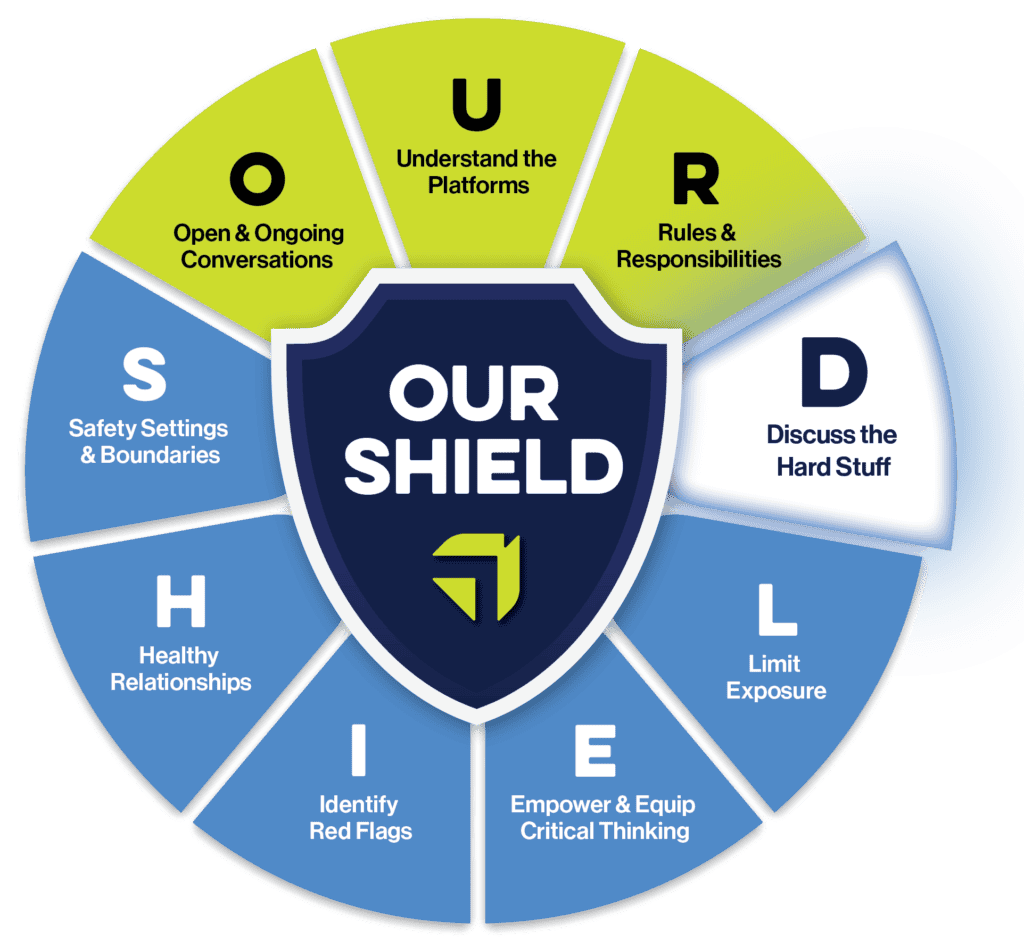
Talk openly about serious risks like pornography, sextortion, CSAM (child sexual abuse material), and deepfakes in age-appropriate ways. Stay informed. Sextortion is one of the biggest dangers currently affecting teens.
Sara is having these conversations with her daughter after another child in her extended family had a near brush with a sextortion scam.
He was chatting with someone he thought was a girl on Instagram. Then the person asked for $5,000 or send explicit photos to the top ten people on his account. He shut it down but they still sent the photos,” said Sara.
The American Psychological Association emphasizes that social media can both benefit and harm adolescents, depending on how it’s used, outlining recommendations to ensure that teens develop healthy social media practices. The experiences of teen girls on social media skew more negative, at times: Teen girls are more likely than boys to say social media hurt their mental health (25% vs. 14%), confidence (20% vs. 10%) or sleep (50% vs. 40%), according to a Pew Report.
Teach: “When you hit send, it’s out there.” Help them understand the permanence of online actions.Talk about reputation, privacy, and audience: “Would you post this if a future employer or family member saw it?
SHIELDING STRONG FOR THE FUTURE
A shield stands for more than protection, but symbolizes boundaries and empowerment. It’s also a tool to stand strong from both physical and emotional harm.
“We can’t shield them from everything. But we can give them the confidence to ask questions and trust their gut,” said Kristin, a mother of a 6-year-old son.
In this spirit, Our Shield™ is designed to meet families where they are, helping parents stay more informed and connected to their kids. This guide also helps kids learn to think, ask for help, and feel safe online. With the Our Shield™ platform, we offer guidance for discussions throughout their childhood, broken down by three different age groups, from birth to early childhood, middle childhood and adolescence.Platforms and technology will change and continue to advance, but what remains deeply foundational in our online journeys are the lessons within Our Shield™meant to evolve with our digital world and our families. Together, let’s raise a generation of kids who are not just shielded, but strong. Our Rescue’s greatest hope is that it becomes a movement to build astute and aware digital citizens over a lifetime.
